Rank on Google's first page in 3 months
Backlinks Outreach: What It is and Should You Do It?
Jan 09, 2024 | Athira K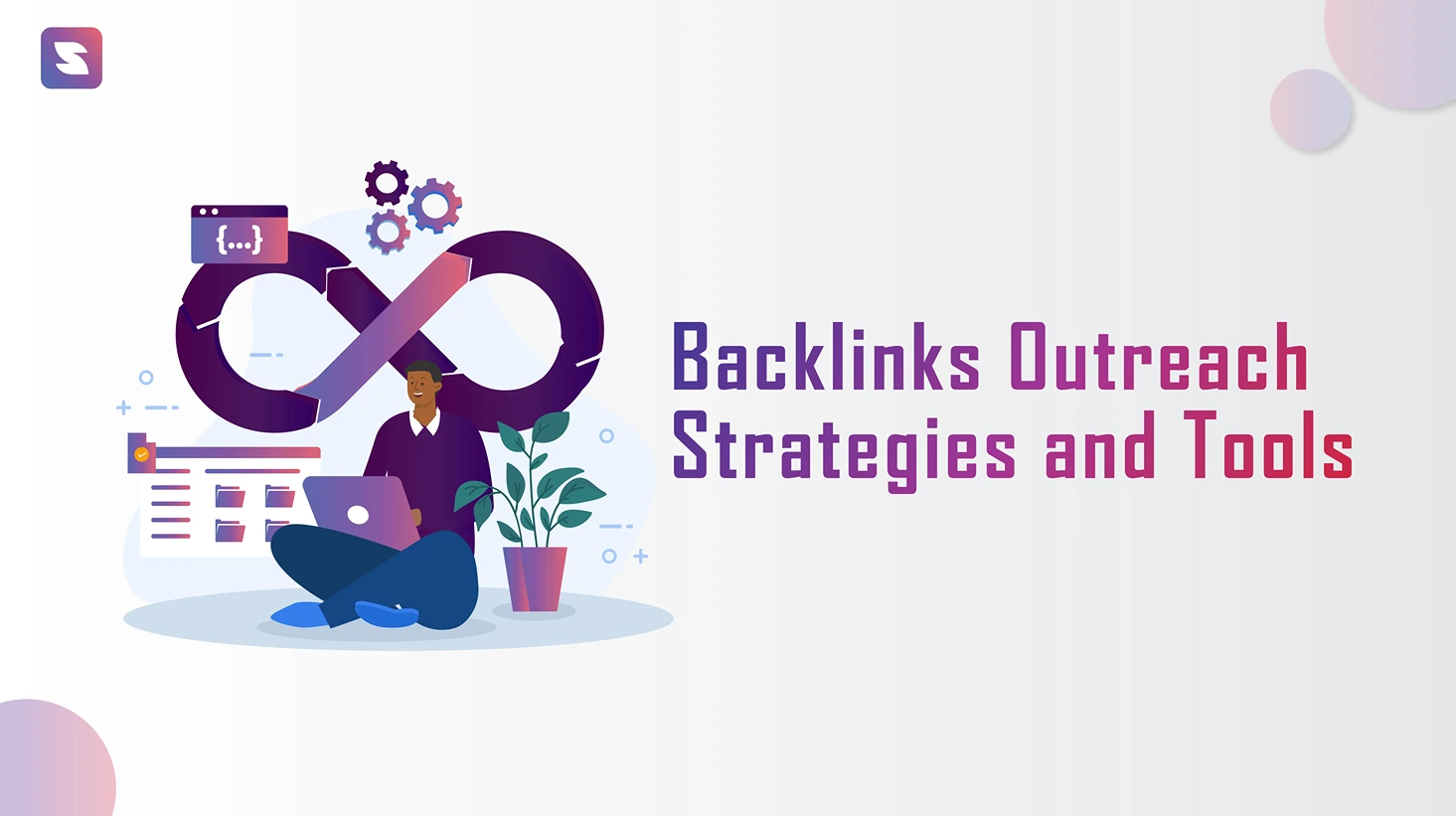
The more high-quality backlinks you have, the more valuable Google considers your site, boosting your position in search results.
But it’s not just about having many backlinks; their quality matters more. Quality backlinks from trusted sites are key to improving your site’s visibility.
Building a quality backlink profile requires a strategic approach. This is where backlink outreach comes in. It involves reaching out to other websites to earn valuable backlinks and enhance your site’s credibility and ranking. However, this process has challenges, like finding the right partners and sending effective outreach messages.
In this blog post, we’ll guide you through the best strategies and tools for successful backlinks outreach, helping you improve your SEO practically and effectively.
What is Backlink Outreach?
Backlinks outreach is a strategic approach to building relationships with other websites to secure backlinks. These backlinks are hyperlinks from other websites that lead back to your site.
Now, you might wonder, “How does backlink outreach fit into digital marketing and SEO?” The answer lies in how search engines like Google perceive and rank websites.
Search engines use specific algorithms to evaluate the relevance and authority of a website. One of the critical factors in this algorithm is the number and quality of backlinks a website has.
Having high-quality backlinks increases credibility, which, in turn, can improve ranking on search engines. Backlink outreach is an essential component of SEO. It’s not just about getting any backlinks; it’s about getting the right ones.
By focusing on building relationships with authoritative sources and earning high-quality backlinks, you can significantly enhance your website’s visibility in the eyes of both users and search engines.
How to Outreach for Backlinks: Types And Strategies
Let’s break down the types of backlink outreach and explore some practical strategies to help you understand how it’s done.
1. Guest Posting
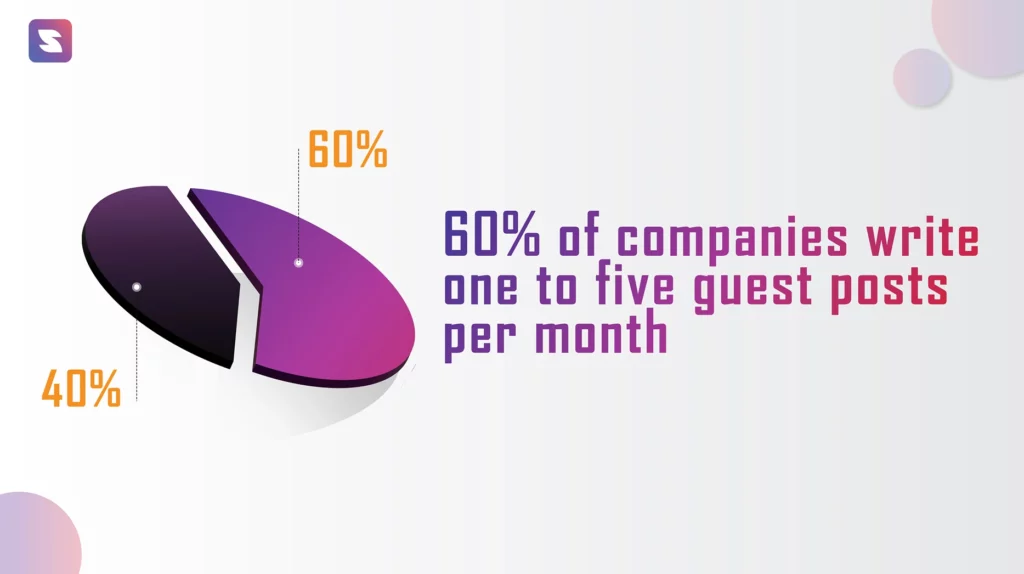
Guest posting is about offering to write content for another website in your niche. It’s a win-win: they get quality content, and you get a backlink.
So, how can you do guest posting?
1. First, You Have To Find The Best Sites For Guest Posting
You have to find suitable websites where you can guest post. You can list the websites to help you connect with your target audience. Always remember to list the sites relevant to your niche rather than directly in competition with you.
You can google it by some search terms like:
- “Write For Us” + [niche/ topic/ industry]
- “disclosure policy” blog + [niche/ topic/ industry]
- “guest post” + [niche/ topic/ industry]
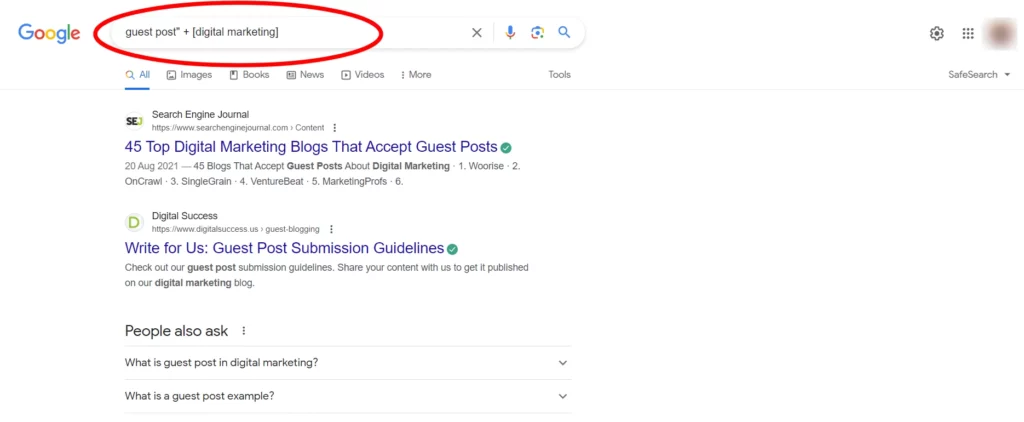
This will help you find blogs that welcome guest post opportunities. Once you get the list of the websites, you can go to the second stage, which is to research their guest post guidelines.
2. Thorough Check The Website And Guest Post Guidelines
Then, you must thoroughly check the websites you have listed to get to know the guest post guidelines. You can ask yourself some questions by checking the website like:
- What kind of posts do they accept?
- What is the blog’s domain and page authority?
- How much traffic does the website get?
- How does their social media reach
Now that you have answers to these questions, you can create a rearranging section. List potential blogging websites and prioritize contacting the more promising blogs likely to accept your guest post outreach. Identify which sites would bring you the most benefits.
After this, you must develop a winning, catchy content idea for your potential guest blogging websites.
3. Develop The Best Content Ideas
After all the steps, the main thing is creating winning content ideas for your guest post websites. Bloggers should have taken more simple content they write; they only need high-quality content to drive traffic, social media shares, conversions, and comments to their website.
You can find out the potential keywords and content ideas that come with your niche; you can get ideas from a keyword research tool and discover the keyword and other related keywords that you can target for a potential guest post.
Also Read: Importance of Content Relevance
4. Craft A Compelling Pitch For Your Guest Post
After you find the right websites, contacts, and content, it’s time to reach out to the website, and before that, you can check out some effective templates.
- Template 1: Expertise-Driven Guest Post Offer
| Subject: Exclusive Guest Post Proposal for [Site Name] from an Industry Expert Hi [Site Owner], I’ve been an avid reader of [Site Name] and particularly enjoyed your recent piece on [Specific Topic or Article]. Your insights on [Specific Point] were spot on! As an expert in [Your Niche] with over [X years/months] of experience, I can offer your audience unique value. My work has been featured on [Notable Site 1] and [Notable Site 2], where I delve into topics like [Specific Topic]. I want to propose a guest post for [Site Name] on one of the following topics, which I believe will resonate with your readers: [Topic Idea 1] – Offering a fresh perspective on [Brief Description]. [Topic Idea 2] – An in-depth look at [Brief Description]. [Topic Idea 3] – How [Brief Description] is changing the [Your Niche] landscape. I want to share my insights with your audience and would love to discuss this further. Please let me know if any of these topics interest you or if there’s another subject you’d prefer. Thank you for considering my proposal. I’m excited about the possibility of contributing to [Site Name]. Warm regards, [Your Name] |
- Template 2: Value-Added Collaboration Proposal
| Subject: Let’s Collaborate: Exciting Opportunity for [Site Name] and [Your Blog Name] Hi [Site Owner], I recently discovered [Site Name] and was impressed by your comprehensive coverage of [Specific Topic]. We share a passion for [Your Niche], and collaboration could be mutually beneficial. I run [Your Blog Name], where we focus on [Specific Aspect of Your Niche]. Our content has been featured on platforms like [Notable Site 1] and [Notable Site 2], and we have a dedicated following eager for quality content. Here are a few collaboration ideas that could provide significant value to both our audiences: Guest Post Exchange: I write an exclusive piece for your site, and you contribute to mine, offering fresh content and perspectives to our readers. Joint Webinar or Podcast: We could co-host a session on [Relevant Topic], tapping into our expertise to engage our audiences. Co-Authored Research or Whitepaper: Combining our knowledge to create a comprehensive guide or report on [Relevant Topic]. I’m open to other collaboration ideas you might have and would love to discuss how we can make this partnership fruitful. Looking forward to the possibility of working together. Best regards, [Your Name] |
- Template 3: Gentle Reminder and Offer to Adapt
| Subject: Revisiting Our Guest Post Conversation – Ready to Tailor to [Site Name] ‘s Needs Hi [Site Owner], I hope you’re doing well. I reached out with a guest post proposal for [Site Name] a little while ago. I understand you’re busy, so I’ll keep this brief. I’m still very enthusiastic about contributing to your site and am more than willing to adapt my content to fit your editorial needs. Whether it’s a deep dive into [Specific Topic] or a practical guide on [Another Topic], I’m ready to craft content that aligns perfectly with your audience’s interests. If you have any specific topics or themes in mind, or if there’s any additional information I can provide, please let me know. I’m here to make this process as seamless and beneficial for you as possible. Thank you for considering my proposal, and I hope to hear from you soon. Warm regards, [Your Name] |
These templates aim to balance professionalism and personalization with a clear focus on the value proposition for the site owner. Remember, the key to successful outreach is not just in the initial contact but in the follow-up and adaptability to the needs of the site you’re reaching out to.
The Don’ts of Guest Post Blogging
When it comes to guest post blogging, it’s essential to keep a few don’ts in mind like:
- Make sure you follow each blog’s submission guidelines. You’ll be accepted if you pay attention to these.
- Provide value first; excessive self-promotion will turn off both you and your readers.
- Make sure you submit original, plagiarism-free content. Copying content can hurt your reputation.
- Even though SEO is essential, don’t stuff your content with keywords.
- Make sure your content aligns with the blog’s audience’s interests. Readers won’t care about irrelevant content.
- Keep in touch with the blog owner after the post is published. It’s critical for long-term collaboration.
- Only include relevant links that are valuable to the content. Irrelevant links can detract from the quality of your post.
- Avoid submitting the same or very similar content to multiple blogs. Unique and tailored content is more likely to be accepted and appreciated.
2. Broken Link Building
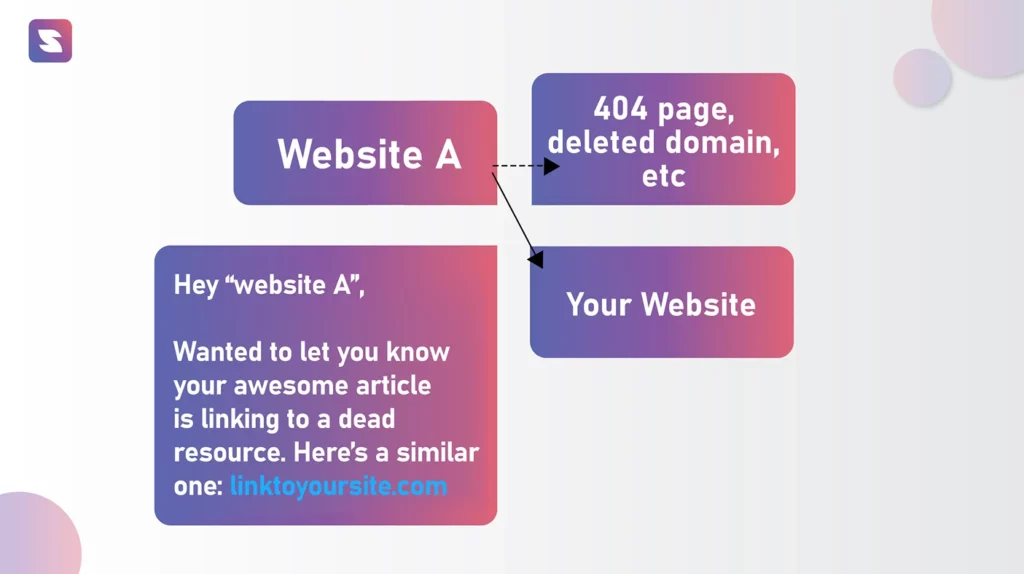
Broken link-building is another outreach strategy that is a popular link-building tactic. It is a strategic approach in SEO that involves identifying broken links on websites and suggesting your content as a replacement. This method helps improve the user experience on the host website and allows you to gain valuable backlinks. It’s helpful for the site owner and beneficial for you.
Steps for Broken Link Building:
1. Finding Broken Pages with Backlinks:
- Use a broken checker tool like SuiteJar to get the complete list of broken links on the website.
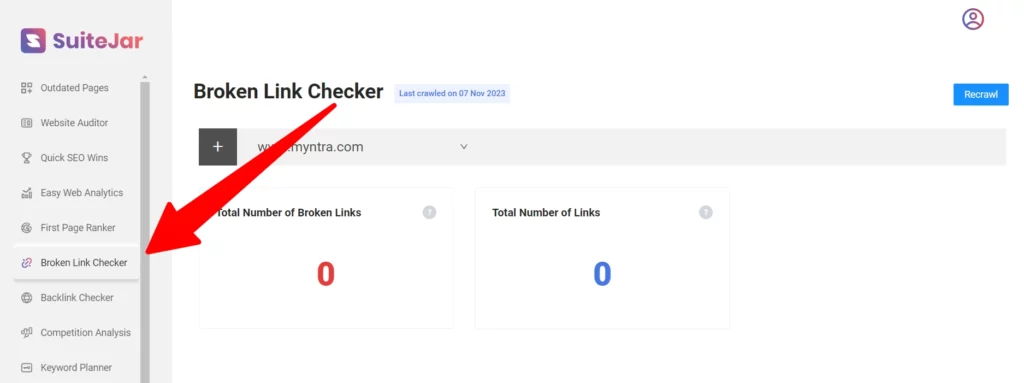
- Enter the domain you’re interested in to find broken links.
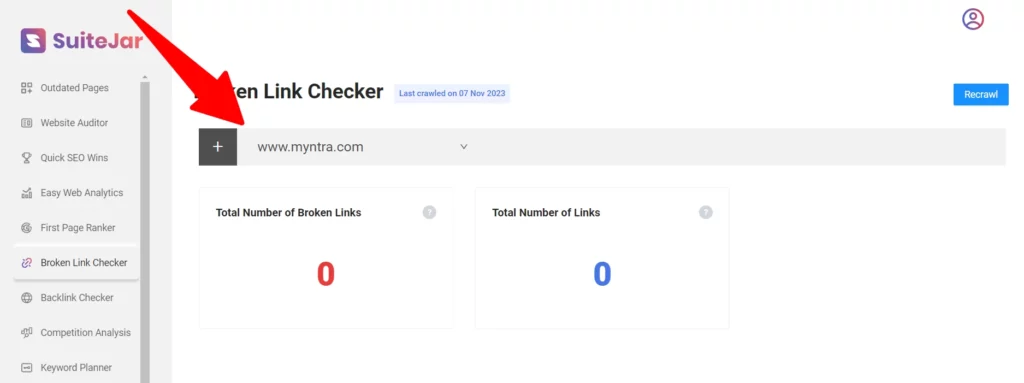
- The tool provides details like the broken link, its type, URL, and associated error.
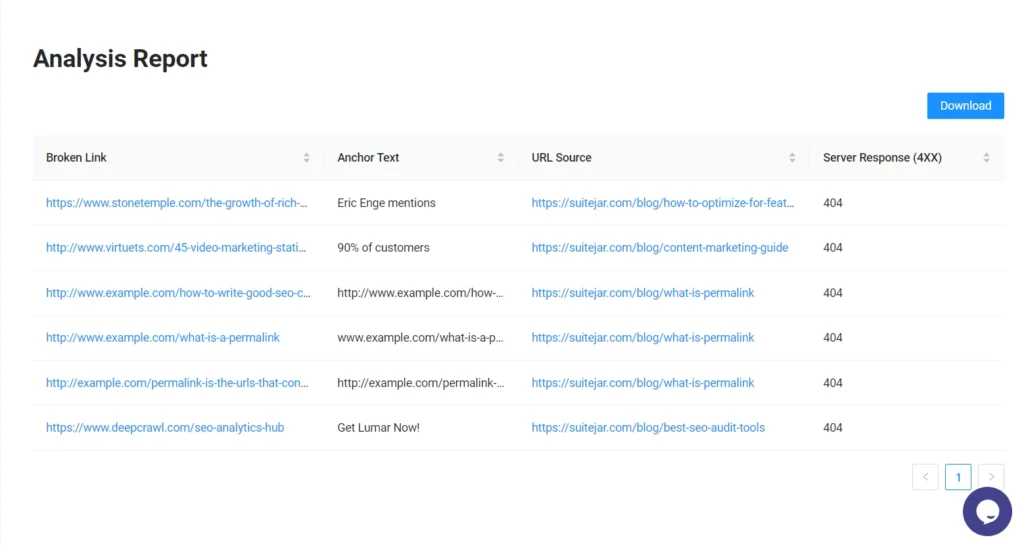
2. Evaluating the Broken Links:
Once you have a list of broken links, assess each for relevance to your content. Determine if your content can be a suitable and valuable replacement for the broken link.
3. Creating or Tailoring Content:
If you don’t have existing content that fits, create new content that is informative and relevant to the context of the broken link. If you have relevant content, consider tailoring it slightly to suit the context where the broken link was found better.
4. Outreach to Website Owners:
Craft personalized outreach emails with broken links to the owners or web admins of the sites. Clearly explain the broken link issue and how your content can be a valuable replacement. Highlight the mutual benefit: their website regains a valuable resource, and you gain a backlink.
5. Follow-up:
Send a polite follow-up email if there’s yet to be a response to your initial outreach. Be persistent but respectful, understanding that website owners are often busy.
These steps will help you use broken link building as an outreach method for effective link building. This strategy not only aids in enhancing your website’s SEO profile but also assists other site owners in maintaining the quality and integrity of their online content.
3. Resource Page Link Building
Resource page link building involves listing your content on resource pages of websites within your industry. These pages are often curated collections of links to external resources, making them valuable for acquiring quality backlinks.
For example, if you’ve developed a guide on ‘SEO Best Practices for E-commerce,’ you could look for a resource page that curates content on digital marketing. Such a page might include links to various tools, insightful blogs, and informative websites about digital marketing strategies, where your guide could be a valuable addition.
Look into this:
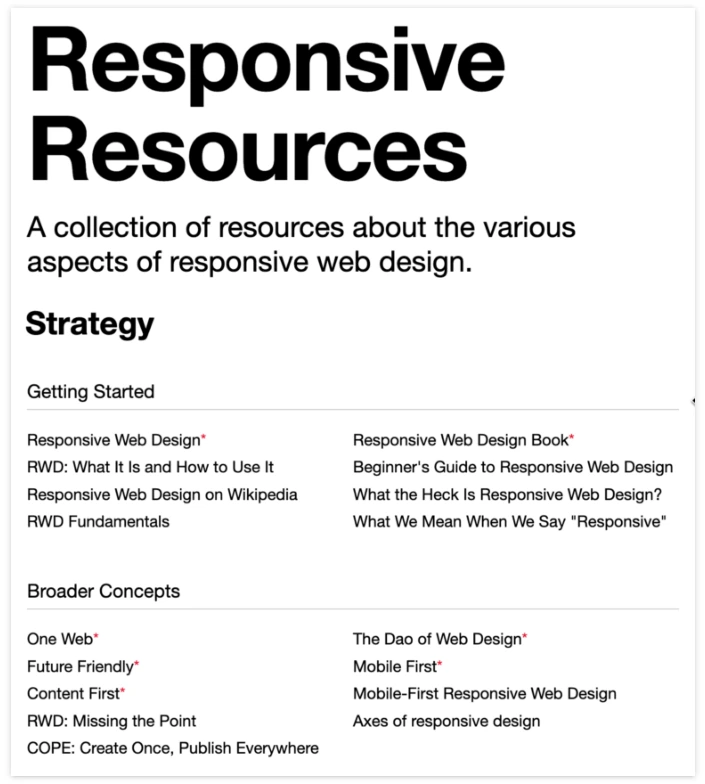
This is what a resource page looks like. If you have better design resource content, you can contact the creator by email and suggest it for inclusion.
1. Identifying Relevant Resource Pages:
- Use advanced Google search operators to find resource pages in your industry. For example, if your niche is digital marketing, you might use queries like “digital marketing + resources” or “online marketing + useful links.”
- Analyze the search results to identify well-maintained, relevant pages with a high domain authority.
2. Evaluating the Resource Pages:
- Once you find potential resource pages, assess their relevance to your content. Ensure your content matches the resource page’s theme and can add value to it.
- Check the quality of the existing links on the resource page. A page with high-quality, relevant links is more valuable than one with outdated or irrelevant resources.
3. Creating or Tailoring Your Content:
- Ensure your content is comprehensive, up-to-date, and offers unique insights or information that the resource page still needs to cover.
- If necessary, tailor your existing content better to fit the theme and requirements of the resource page.
4. Outreach to Page Owners:
- Craft personalized outreach emails to the owners or web admins of the sites with the resource pages. Highlight how your content can enhance their page and provide additional value to their readers.
- Be clear, concise, and professional in your communication, and provide a direct link to your content for their review.
5. Follow-Up and Relationship Building:
- If you don’t receive a response, send a polite follow-up email. Persistence and respect for the site owner’s time can be crucial to success.
- Engage with the website or its social media channels to build a rapport, which can increase the likelihood of your content being featured.
4. Skyscraper Technique
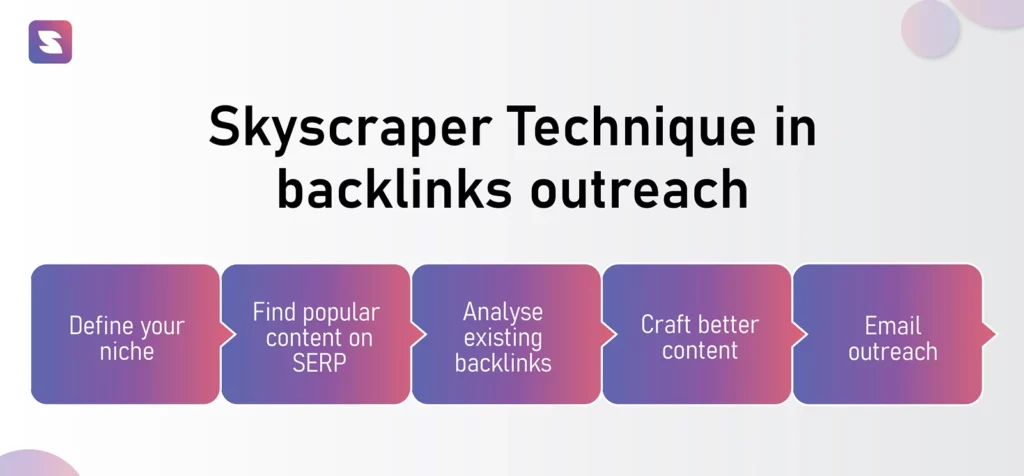
The Skyscraper Technique is a powerful link-building strategy that improves existing popular content and replicates its backlinks. This technique, created by Brian Dean of Backlinko, is based on the principle that people are naturally drawn to the best or most impressive content in any field.
The Skyscraper Technique involves three key steps:
- Identifying Popular Content: Find content within your niche with many backlinks and ranks well in search engine results.
- Creating Superior Content: Develop more comprehensive, up-to-date, and overall better than the identified popular content.
- Outreach for Backlinks: Reach out to websites linked to the original and persuade them to link to your improved version instead.
Use this step-by-step strategy
1. Get a Backlink Analysis Tool
Start by choosing a backlink analysis tool like SuiteJar. This tool will help you identify the top-ranking articles on Google for your target keyword.
Next, enter the URLs of these top-ranking articles into the SEO tool. Analyze why these articles are performing well, focusing on content depth, user engagement, and topics covered. Export the data into an Excel sheet for a detailed analysis. This will help you track and organize your findings.
2. Make Email Templates
Develop several email templates for outreach. Personalization is key, so ensure each template can be easily customized for different website owners. Test different templates to see which yields more responses.
Keep track of response rates to refine your templates over time.
3. Identify High-Performing Content
After exporting the URLs, scrutinize these articles to understand their strengths and weaknesses. Look for opportunities where you can add more value.
Note what makes these articles popular – is it their comprehensive nature, the freshness of content, or how information is presented?
4. Create Superior Content
Develop more detailed, up-to-date, and engaging content than the original pieces. This might include adding recent statistics, comprehensive guides, or interactive elements like infographics.
Make sure your content is of high quality and optimized for keywords to boost visibility in search engine results.
5. Outreach to Website Owners
Use your email templates to reach out to the owners of websites that have linked to the original content. Customize each email to highlight how your content provides additional value.
In your emails, focus on what makes your content stand out. Is it more current, more in-depth, or does it cover aspects the original article missed?
6. Follow-Up
If there’s no initial response, send a polite follow-up email. This can increase your chances of securing a backlink. Record your outreach efforts, responses received, and links gained. This data is invaluable for refining your Skyscraper Technique strategy.
Following these steps, you can use the Skyscraper Technique to enhance your website’s backlink profile. The key to success with this strategy is creating better content and effective outreach and building relationships with other website founders in your niche.
5. Infographics Outreach
Infographics are visually appealing, easy to understand, and shareable. And that makes them an excellent tool for attracting attention and backlinks. They can simplify complex data, present exciting statistics, or provide a quick topic overview, appealing to content creators and their audiences.
i. Develop an Effective outreach.
To develop a high-quality infographic, start by selecting a topic that resonates with your audience and is pertinent to your niche, ensuring that the data presented is accurate, current, and engaging. It should captivate the viewer’s attention with a clear layout, easily readable fonts, and a color scheme that reflects your brand’s identity.
Utilizing design tools such as Canva or Adobe Illustrator can significantly aid in creating an infographic that is both informative and visually impactful.
ii. Research and Identify Target Websites/Bloggers:
Find the Right Audience: Use tools to identify websites, blogs, and influencers that share content in your niche. Look for those who have previously shared infographics or similar content. Create a list of potential websites and contacts, including their contact information and any relevant notes about their content preferences or guidelines.
iii. Craft Personalized Outreach Messages:
Tailor Your Pitch: Personalize each outreach email. Mention specific content they have shared that aligns with your infographic and explain how your infographic adds value to their audience. Clearly state your request and make it easy for them to view and download the infographic. Please include a brief description, the infographic itself, or a link to it.
iv. Promote Across Social Media:
Leverage Your Channels: Share your infographic on your social media platforms. Tag relevant influencers or bloggers and use appropriate hashtags to increase visibility. Encourage your followers to share the infographic and engage with any comments or shares to foster a community around your content.
v. Follow Up and Build Relationships:
Polite Follow-Up: You can send a polite email if you have not heard from them within a week or two. Remind them of your first message and express your belief in the value your infographic can add to their content. For those who share your infographic, thank them and continue to engage with their content.
These five strategies require a blend of tact, research, and persistence. The key is approaching each opportunity with a mindset of adding value to the site you’re reaching out to and their audience.
Tailor your approach, be respectful, and remember, successful backlink outreach is as much about building lasting relationships as securing a single link.
Common Mistakes to Avoid in Backlink Outreach
Backlink outreach is a critical component of SEO strategy, but it’s easy to fall into certain pitfalls.
Here are five common mistakes to avoid and practical solutions for each:
1. Generic, Impersonal Emails
Sending the same templated email to multiple recipients. These often need more personalization and engagement of the recipient.
- Fix: Tailor each outreach email. Mention specific details about the recipient’s content, express genuine interest in their work, and explain why your content adds value to their site.
2. Targeting the Wrong Websites
Reaching out to websites that need to be more relevant to your niche or content. This can lead to a low response rate and poor-quality backlinks.
- Fix: Conduct thorough research to identify websites that align with your niche. Use tools like Moz’s Domain Authority to assess the quality and relevance of potential outreach targets.
3. Overlooking the Quality of Your Content
Focusing solely on the number of outreach attempts without ensuring the content you’re promoting is high-quality and valuable.
- Fix: Before initiating outreach, make sure your content is well-researched, informative, and offers something unique to the audience.
4. Being Too Aggressive in Follow-Ups
Sending too many follow-up emails or coming across as pushy can annoy recipients and harm your reputation.
- Fix: Follow up politely and no more than twice. If there’s no response after two follow-ups, move on to other prospects. Respect the recipient’s time and decision.
5. Neglecting to Build Relationships
Treating backlink outreach as a one-time transaction rather than an opportunity to build a lasting relationship.
- Fix: Focus on building a rapport with the website owners and editors. Engage with their content regularly, offer value in your communications, and maintain contact even after a successful backlink placement.
By avoiding these common mistakes and implementing these fixes, your backlink outreach efforts can become more effective, leading to better quality backlinks and stronger relationships within your industry.
Best Tools for Backlink Outreach
Besides conducting thorough research and avoiding common mistakes, utilizing the right backlink tools can significantly improve your outreach efforts.
Here are some of the best tools for backlink outreach:
1. SuiteJar
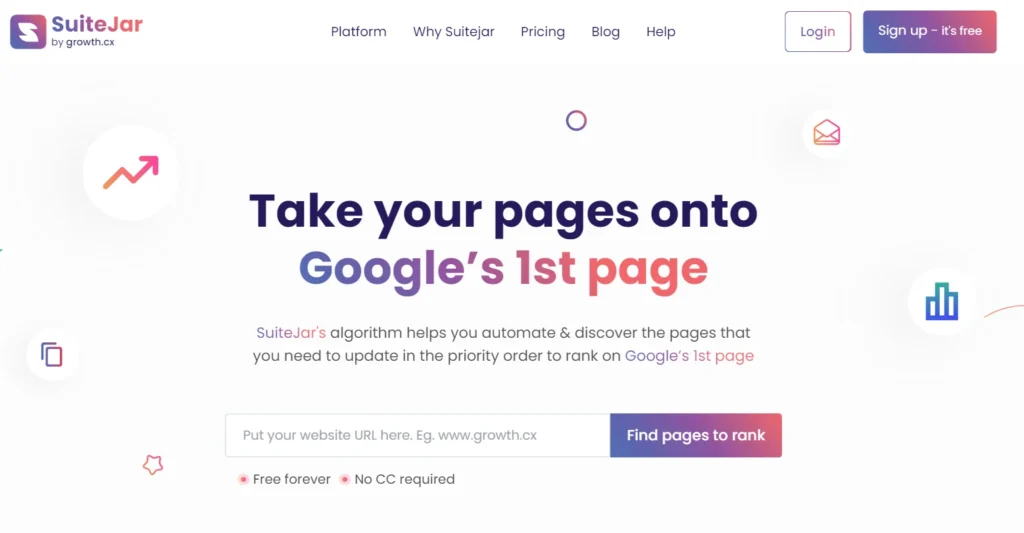
SuiteJar is the best SEO tool for boosting your backlink strategy. With a backlink checker, competitor analysis, and broken link checker, it’s your go-to for effective link building.
You can upload your competitor’s websites in the backlink checker feature and get the complete list of their backlinks. Get the total number of backlinks, source URLs, anchor text, targeted URLs, and the first and last seen.
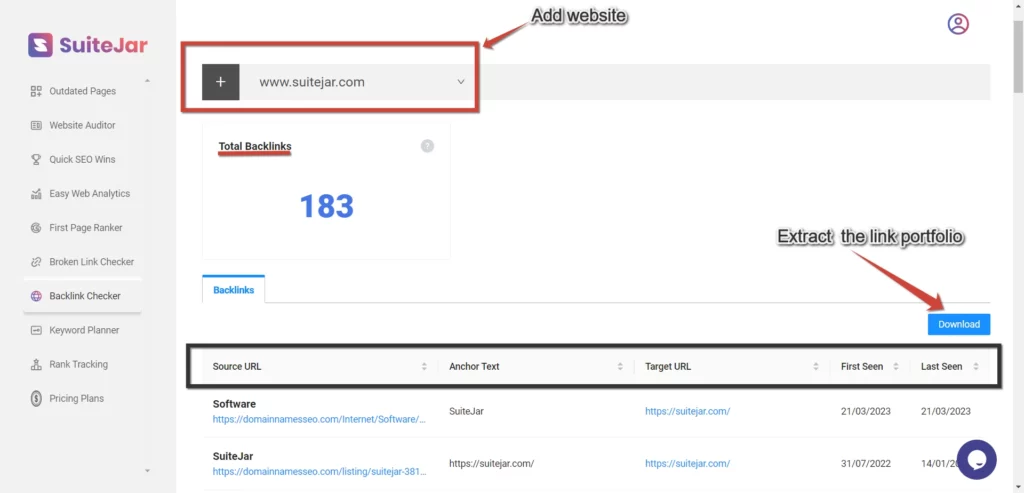
The competitor analysis feature provides a complete analysis of your competitor’s websites with DA, spam score, organic traffic, keywords, and backlinks.
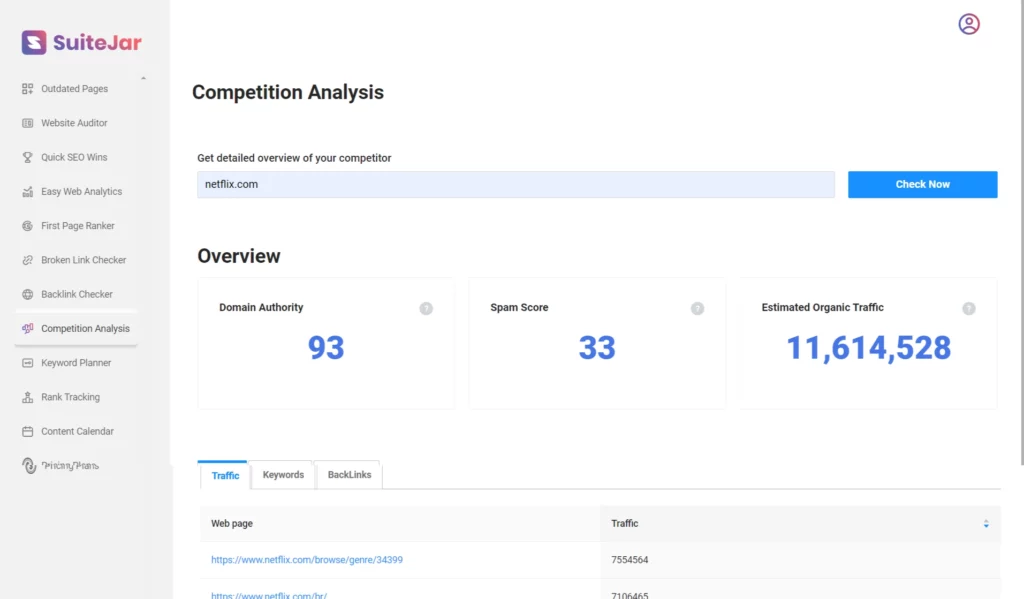
The broken link checker feature helps you identify the broken links in the website. It gives insights into the total number of links, broken links, broken link type, source URL, and the error.
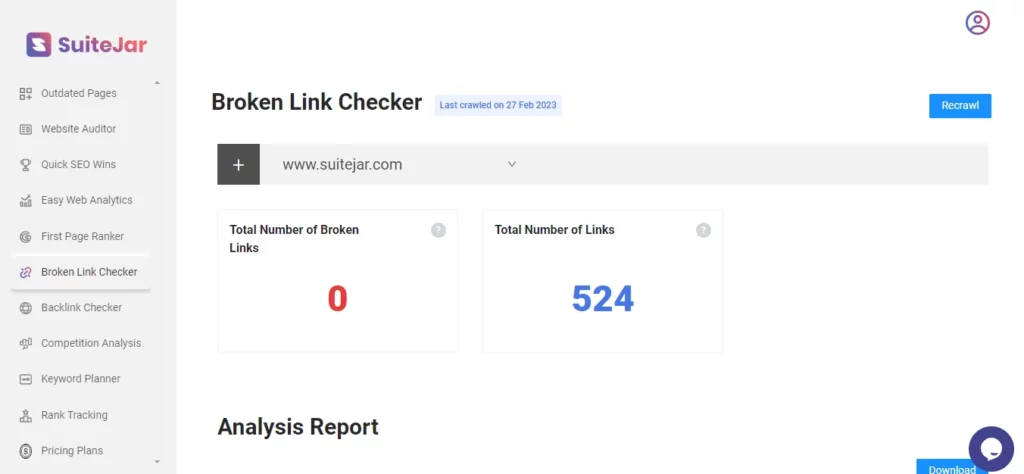

2. Ahrefs
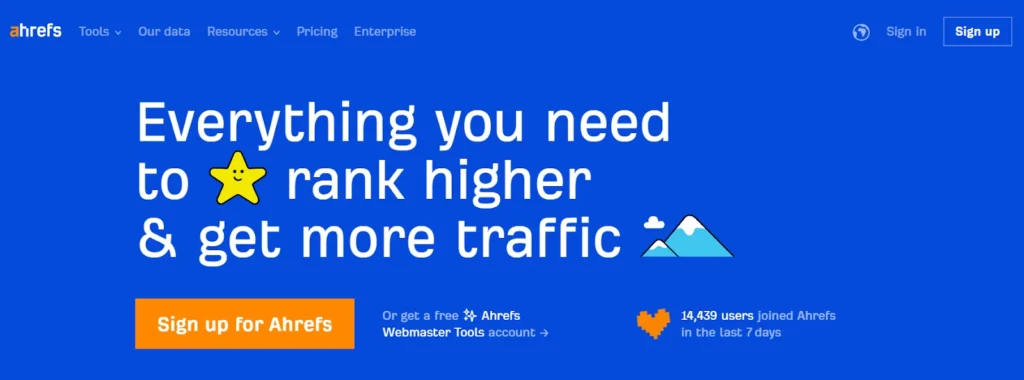
Ahrefs is a competitor analysis tool that offers a suite of features useful for link building. Its Site Explorer provides insights into a website’s backlink profile, crucial for identifying potential link-building opportunities. Ahrefs helps identify high-quality link prospects and understand competitors’ strategies, making it easier to tailor your outreach.
3. BuzzSumo
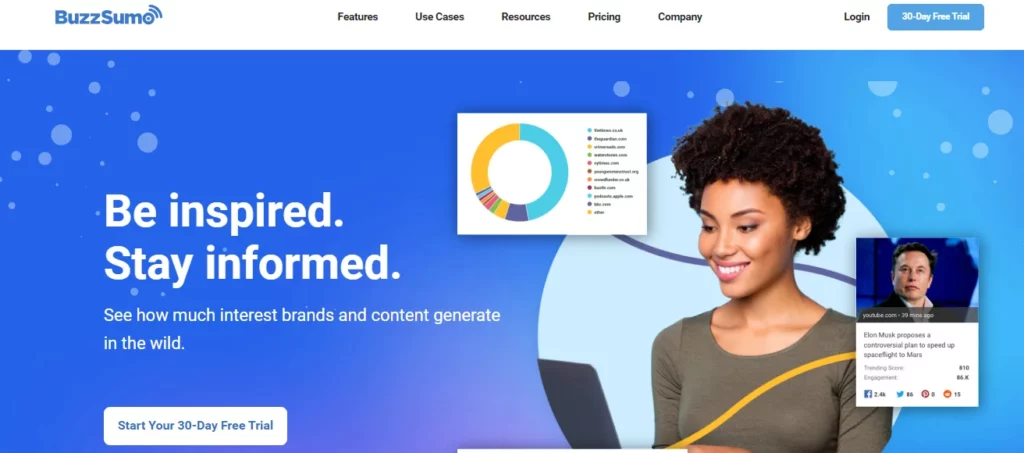
BuzzSumo is a tool for content research and discovering influential content creators in various niches. It’s beneficial for identifying popular content that attracts backlinks. BuzzSumo is ideal for content-driven link-building strategies and for connecting with influencers who can amplify your content’s reach.
Conclusion
Backlink outreach is a crucial aspect of any successful SEO strategy.
By thoughtfully applying the right tools and techniques, you can significantly strengthen your website’s backlink profile, which is pivotal for enhancing search engine rankings. Building high-quality, relevant backlinks takes time and effort, but the results are well worth it for your website’s organic traffic and visibility on search engines.
Continuously monitor and analyze your backlinks’ performance to gauge the effectiveness of your strategies and make informed adjustments. This ongoing learning, application, and evaluation process is key to long-term success.
So, incorporate these strategies into your SEO plan and continue to monitor and improve your backlink profile for long-term success.
